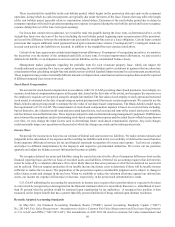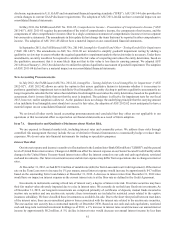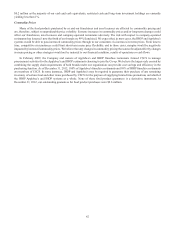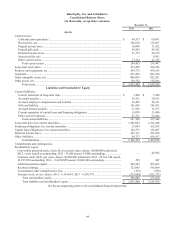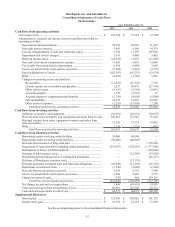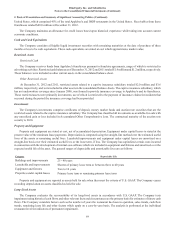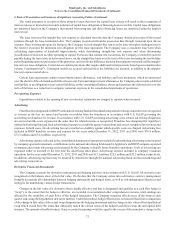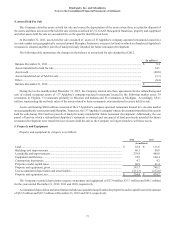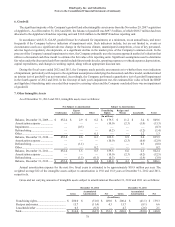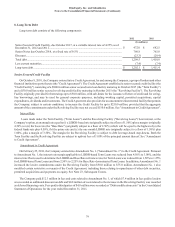IHOP 2012 Annual Report Download - page 88
Download and view the complete annual report
Please find page 88 of the 2012 IHOP annual report below. You can navigate through the pages in the report by either clicking on the pages listed below, or by using the keyword search tool below to find specific information within the annual report.DineEquity, Inc. and Subsidiaries
Notes to the Consolidated Financial Statements (Continued)
2. Basis of Presentation and Summary of Significant Accounting Policies (Continued)
70
Recoverability of a restaurant's assets is measured by comparing the assets' carrying value to the undiscounted future cash
flows expected to be generated over the assets' remaining useful life or remaining lease term, whichever is less. If the total expected
undiscounted future cash flows are less than the carrying amount of the assets, this may be an indicator of impairment. If it is
decided that there has been an impairment, the carrying amount of the asset is written down to the estimated fair value as determined
in accordance with U.S. GAAP governing fair value measurements. The primary method of estimating fair value is by discounting
the future cash flows based on the Company's cost of capital. A loss resulting from impairment is recognized as a charge against
operations.
The Company may decide to close certain company-operated restaurants. Typically such decisions are based on operating
performance or strategic considerations. In these instances, the Company reserves, or writes off, the full carrying value of these
restaurants as impaired.
On a regular (at a minimum, semi-annual) basis, the Company assesses whether events or changes in circumstances have
occurred that potentially indicate the carrying value of long-lived assets may not be recoverable. See Note 15, Impairment and
Closure Charges.
Goodwill and Intangible Assets
Goodwill is recorded when the aggregate purchase price of an acquisition exceeds the estimated fair value of the net identified
tangible and intangible assets acquired. Intangible assets resulting from the acquisition are accounted for using the purchase method
of accounting and are estimated by management based on the fair value of the assets received. Identifiable intangible assets are
comprised primarily of trademarks, tradenames and franchise agreements. Identifiable intangible assets with finite lives (franchise
agreements, recipes, menus and favorable leaseholds) are amortized over the period of estimated benefit using the straight-line
method and estimated useful lives. Goodwill and intangible assets considered to have an indefinite life (primarily tradename and
liquor licenses) are not subject to amortization. The determination of indefinite life is subject to reassessment if changes in facts
and circumstances indicate the period of benefit has become finite.
Goodwill has been allocated to three reporting units, the Applebee's company-operated restaurants unit ("Applebee's company
unit"), the Applebee's franchised restaurants unit ("Applebee's franchise unit") and the IHOP franchised restaurants unit ("IHOP
franchise unit"), in accordance with U.S. GAAP. The significant majority of the Company's goodwill resulted from the
November 29, 2007 acquisition of Applebee's and was allocated between the two Applebee's units. The goodwill allocated to the
Applebee's company unit was fully impaired in 2008.
The Company has elected to bypass the option allowed under U.S. GAAP to perform a qualitative assessment of goodwill
and other indefinite life intangible assets for impairment. The Company performs a quantitative test for impairment on an annual
basis. The impairment test of goodwill of the Applebee's franchise unit and the tradename of the Applebee's company and franchise
units is performed as of October 31 of each year. The impairment test of the goodwill of the IHOP franchise unit is performed as
of December 31 of each year. In addition to the annual test of impairment, goodwill and indefinite life intangible assets are evaluated
more frequently if the Company believes indicators of impairment exist. Such indicators include, but are not limited to, events or
circumstances such as a significant adverse change in the business climate, unanticipated competition, a loss of key personnel,
adverse legal or regulatory developments or a significant decline in the market price of the Company's common stock.
In the process of the Company's annual impairment review of goodwill, the Company primarily uses the income approach
method of valuation that includes the discounted cash flow method as well as other generally accepted valuation methodologies
to determine the fair value of goodwill and intangible assets. Significant assumptions used to determine fair value under the
discounted cash flows model include future trends in sales, operating expenses, overhead expenses, depreciation, capital
expenditures and changes in working capital, along with an appropriate discount rate based on the Company's estimated cost of
equity capital and after-tax cost of debt. The first step of the quantitative impairment test compares the fair value of each of our
reporting units to their carrying value. If the fair value is in excess of the carrying value, no impairment exists. If the first step
does indicate impairment, a second step must take place. Under the second step, the fair value of the assets and liabilities of the
reporting unit are estimated as if the reporting unit were acquired in a business combination. The excess of the fair value of the
reporting unit over the amounts assigned to its assets and liabilities is the implied fair value of the goodwill, to which the carrying
value of the goodwill must be adjusted. The fair value of all reporting units is then compared to the current market value of the
Company's common stock to determine if the fair values estimated in the impairment testing process are reasonable in light of the
current market value.


